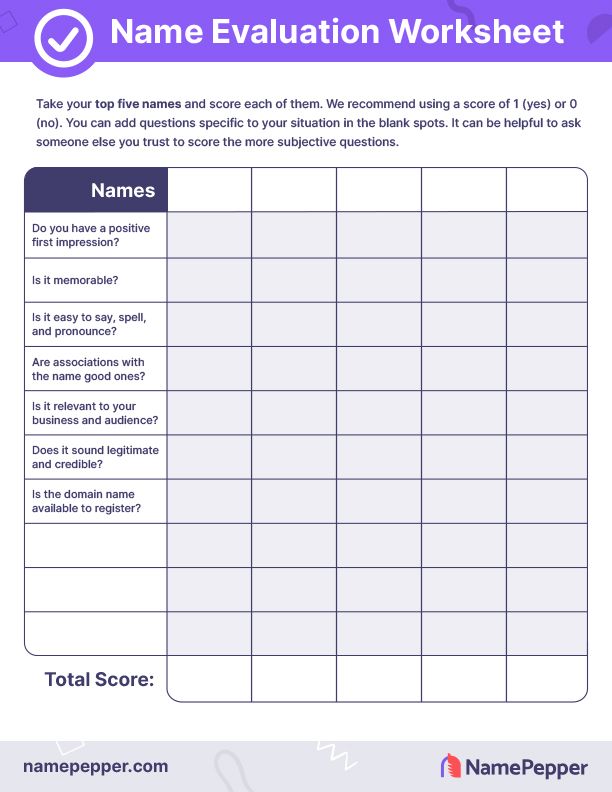Beginner’s Guide on How to Name a Business (Free Worksheet)

Dave Ver Meer · Updated: April 11, 2024

Your business name will likely be the first impression customers have. It should connect people with your brand and tell them what you offer. Through your name and branding, people will start to create a mental association with your business.
Ideally, it’s a positive feeling, but it can be negative depending on their experience. According to Crowdspring, 77% of consumers make purchases based on brand name and 91% say that they are more likely to buy from an authentic brand.
There’s a lot riding on your name so you should take your time. You can change the name later, but if it doesn’t fit to begin with, building a successful business will be that much harder. That said, it doesn’t need to be perfect or communicate everything.
As you think about getting started, try not to feel overwhelmed–I’ll walk you through step-by-step on how to name your business. By the time you’re done, you’ll be a naming pro.
In this guide, we'll cover the following steps:
- Lay the groundwork
- Brainstorm a bank of words
- Generate name ideas
- Collect the best ideas
- Check your name ideas (Evaluation Worksheet)
- Get feedback from others
- Pick a final name

Lay the groundwork
To get started, focus your efforts by thinking through a few questions first. It’ll help you with brainstorming and when it’s time to narrow down name ideas.
If you think of some ideas or words as you answer these, jot them down for use in the next steps.
What am I naming?
This may seem like an obvious question, but it’s worth considering. The name may include a benefit you offer, your star product/service, or your type of business. Or all of them.
For example, a coffee shop could focus on the experience with a name like “Aroma Mocha” or on a product with the name “Scone City.” And depending on the type of business, it might even be abstract or invented, rather than something that has an obvious connection. Like a boutique with the name “Lotana.”
Should I name my business after myself?
This mostly depends on your specific circumstances. But in general, you shouldn’t name a business after yourself. Here are a few pros and cons to help you decide:
Pros
- Gives credibility to your business if you’re an established authority in your industry or plan on becoming one.
- Can lend authenticy and help build a connection with your customers.
Cons
- It can make your business less attractive to buyers if you ever decide to sell, since the brand is so closely tied to you.
- The name may be less unique, which limits growth in cases where you decide to expand elsewhere and then find out there’s another business with a similar name.
- You’ll have the pressure of always being the public face of a business and having that extra level of scrutiny.
- You could become a liability to your business if something happens in your personal life that damages your public reputation.
- Your first or last name could change someday and then you may have to rebrand.
If you do decide that you want to include your personal name, then add it to the word bank in the next step.
Who is my target audience?
They’re the ones who you need to reach and connect with. Knowing who they are will help you come up with relevant words and choose a name later on.
To define your target audience, think about who you want to help and serve. You could have one audience or multiple. If you have multiple, it’s best to still decide which is your primary audience.
For each audience, define qualities and demographics–like personality, activities they enjoy, what they value, age, and income level.
What makes my business different?
Unless you’re lucky enough to be in a niche market with high demand and few competitors, you’ll need ways to differentiate yourself from competitors.
Start by looking at the qualities of your product, customer service, pricing, overall customer experience, and even location. Maybe you have a product no one else has or it’s a new twist on an existing one.
For example, a drone services business that specializes in flying at night could name itself “Nite Owl Aerial”.
If your business does have a compelling advantage, it’s worth considering how you can include it in the name.

Brainstorm a bank of words
You don’t have to be super creative to brainstorm. Anyone can do it, especially if they follow these techniques and steps. As you brainstorm, avoid judging and silence your inner critic.
Just write down anything that comes to mind. The more, the better. Ideas that you think are bad at first, will often lead you to ideas you wouldn’t have thought of otherwise.
It’s up to you where and when you stop brainstorming. You can always come back to this step if you need more words, and keep repeating the cycle until you find the right name.
Make connections
Brainstorming is about making connections. Think of it as starting with a branch that keeps branching outward again and again. Or a spoke on a wheel that connects to other wheels.
You just need a few places to start, and then things will spiral outward from there. If it helps, you can start by listing out the more obvious words.
Here are some areas and topics you should cover:
Related words
These can be words that are either closely or loosely related to your business. For a boutique shop, some related words are “jasmine”, “stitch”, “basket”, “attire”, “style”, “garden”, and “loft”.
Remember to also include any common industry terms that clearly communicate what your business offers. Try to include a mix of nouns, adjectives, and verbs.
Some topics to look into are:
- Qualities: Consider your product, service, or retail space and think about how they smell or taste, what they look like, or what they’re made of.
- Industry: Think of terms that are related to the products and services you offer. What words does your audience associate them with?
- Benefits: What problem does your business or products solve? What benefits do your customers get? How does your product or service make them feel?
- History: Research the history of your product or industry to see if there are any terms or references that are useful.
- Languages: Words from other languages can be appropriate and fitting in some cases.
- Geography: Are there any geographical features or location specific words that come to mind? (Be careful with these, as tying your name to a specific location could limit your growth options later on.)
- Competitors: It’s wise to review your competitor’s names. Check if there are any words you should avoid and any relevant words to consider using.
Unexpected words
As you add related words to your word bank, keep branching off those until you reach a point where you stop coming up with new words. You might think the most distant words are unrelated, and in a way they are–but I like to think of them as unexpected.
Unexpected words are powerful because they can make the name unique and memorable.
With that in mind, here’s how that might play out. Someone is starting a pet daycare business. They first think of words like “kennel”, “sitter”, “resort”, “paw”, “resort”, “critter”, “protect”, and “fur”.
Then they follow the word “resort” to come up with similar words that are a gathering place that’s relaxing or somehow protected. Which finally leads them to “cove” and they pair that with “critter” to end up with “Critter Cove”.
Use tools
Tools like a thesaurus and dictionary can help you fully explore topics and jump-start things when you hit a roadblock.
Visual Thesaurus makes it really easy and fun to explore branching word associations. Plus, it comes up with associations that you won’t normally find elsewhere.

Generate name ideas
Take the words you’ve come up with and starting combining or adding new ones to them.
A winning formula is to combine a unique word with a well known word that instantly communicates what your business offers. Like “Peachy Clean” for a cleaning service business.
To speed things up, try our business name generator. You can experiment with different name styles and other settings to quickly create hundreds of ideas.
Name types
Most brand names fall into one of these categories or are a combination of them. Think about which ones would be best for your business.
- Descriptive: A name that’s straight forward and makes it very clear what your business does. It’ll usually include common industry terms and words that other competitors also use in their names. Think “Office Depot”.
- Suggestive: Similar to descriptive, but makes it less obvious about what products and services you offer. Think “Netflix”.
- Imagined: These are made up names that are abstract, focus on an emotion, or are just fun to say. Because they are so unique, they can be easier to find available domains for and trademark. Think “Kodak”.
- Acronyms: These have the advantage of being short and easy to say, but they can often confuse your audience. It also takes more effort to educate customers about what your business does. Think “UPS”.

Collect the best ideas
As you look through the ideas, focus on ones that stand out and have the best qualities. Your first impressions matter, because people will decide whether they like a name within a few seconds.
Here are a few qualities to look for when narrowing down your options:
- Relevant: Ask yourself if your audience will respond favorably to the name and if it tells them what your business offers. Different audiences will gravitate to and tend to like certain types of names.
- Memorable: Does the name stick in your head, make a positive impression, and capture your imagination?
- Easy to say and spell: Say the name out loud and ask someone else to spell it. Things like rhyming, alliteration (words start with the same letter), and symmetry (words have the same number of letters) can take a name to the next level.
- Brandable: Does the name have qualities that engage your senses? Can you build a story around it in your branding?
- Flexible: Is the name broad enough to leave room to grow, but specific enough to clearly communicate what you offer? Your business goals will decide where on that spectrum your name should be.

Check your name ideas
Now it’s time to put your names through their paces, and make sure they check all the boxes. Try to cut down your list to a handful of names.
Don’t worry if you cross off all your names in this step. You can always go back and repeat the steps above to create more.
Here are the most common checks that apply to many types of businesses. Check each name to see if it passes.
- Search engine results: Do a Google search using the name and variations of it. Look for similar names that could cause confusion if you were to use the name. You might also find out there is a negative association with the name.
- Search state availability: Most states have a Secretary of State website where you can search for businesses already operating and registered in your state. Search their database to see if the name is in use. Some states also have other naming requirements, like having “LLC” in the name if you form an LLC.
- Domain name availability: Go to a domain registrar like GoDaddy and check if the domain is available. If the exact name is already taken, you can add onto it and search for variations as well. Good domain names are in high demand and go fast. So if you find a domain for a name you really like, consider purchasing the domain right away.
- Social media: Your social media handle isn’t as critical as registering a domain, but it’s worth checking. Do a quick search across social networks with Knowem. You can claim it ahead of time if you find one that fits.
- Trademark: A trademark makes sure you don’t infringe on someone else’s trademark and protects your business name and branding. You should get advice from a lawyer about whether it makes sense to trademark. If you want to see if a trademark is available, you can check the US Trademark Electronic Search System.

Business Name Evaluation Worksheet
Save time and make your decision easier by answering a few questions and comparing your ideas side-by-side.
Get feedback from others
Take the names that passed the checks, and ask people to give you feedback.
Finding out what your target audience thinks of them can be a game-changer, and others will think of things you haven’t.
It’s okay to skip this step if you don’t feel comfortable involving others. If you do decide to get feedback, pick people who will give you their honest opinion and can be objective. Consider people who match your target audience, friends/family, and colleagues.
Pick a final name
Hopefully by this point, you have two or three final contenders.
If you’re torn between a couple names, try checking the names again to see if there are any practical reasons why one name is better than the other.
It’s possible you’ll find the perfect name, but if you don’t, that’s okay.
Picking a good business name that suits your business is better than spending months searching and delaying the launch of your business while you chase after perfection.
When you're ready to work more on your business, our how to start a business checklist can help walk you through the process.
How do I name my LLC?
You shouldn’t name your LLC something that’s too similar to or the same as an LLC already in your state. Some types of businesses may also need to check further abroad in other states and countries.
Many states also have requirements you should research, like requiring “LLC” or some form of it to be in the name. Everything else you need to know to get started naming your LLC can be found in the guide above.
How do I trademark my business name?
If you’ve decided you need to trademark and consulted with a trademark lawyer, you should start by doing a search for existing trademarks. You can use the US Trademark Electronic Search System to search.
If things look good, it’s worth having a professional do a more exhaustive search to make sure there are no potential conflicts. From there, an application needs to be prepared and filed.
Applying is complicated, so I recommend paying a lawyer or using an online service like LegalZoom to make sure it’s done correctly.